Whole Food Plant Based Recipe
What is Poha? How is Poha prepared? Read this Quick Recipe with Spices if This is Your First Attempt at Poha
Poha recipe with simple step-by-step instructions. Poha is a quick & easy Indian breakfast or evening snack made with flattened rice. There are many types of poha in Indian kitchen. Maharashtrian style poha is an especially popular breakfast in North India. Read this recipe to discover how to make the perfect poha with just 2-3 minutes of soaking time.
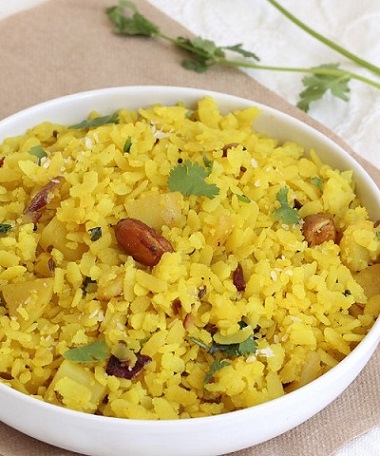
Image credit: SumeetPatel34
What is Thick Poha? Wondering Which Rice Poha is Best for You and Which Brand to Avoid? Revealing Your Best Choice of Poha Today.
There are many varieties of recipes as well as type of poha. Choose the thicker variety for fluffy poha. You can also use it to make instant poha rava for poha rava idli or instant poha idli. Choose the thinner variety for chivda recipe. (check out our poha chivda to find out how it tastes!) If you have an Indian background, you will know exactly which to choose for a quicker version of onion poha or chivda recipe.
Enjoy this delicious Maharashtrian breakfast recipe with a step-by-step recipe card!
How Healthy is Your Poha Recipe? Ditch the Oil and Upgrade to Red Rice Poha in Your Kitchen Today. Yes, even for Chivda!
All kinds of poha are considered healthy. Unfortunately, Any variety of poha made with white rice poha and oil are empty calories. In fact, they are actuallyharmful calories. Oil and white rice are processed foods, leading to a spike in blood sugar levels, cholesterol, and weight. What's worse, they tend to make you hungry again quickly. As blood sugar level spikes, so does insulin secretion, leading a quick drop in sugar levels and hunger sets in.
To make any variety poha healthy, simply ditch the oil and upgrade to red rice poha flakes.
How to garnish poha without oil though? The trick is to use a dry tadka - dry roast mustard seeds, curry leaves, green chillies, cumin seeds and any additional spices in a hot pan without any oil. You won't find instructions saying '1 tbsp oil', 'heat oil', in this poha recipe, whether it is peanut oil, sesame oil or coconut oil. Instead, garnish poha with grated coconut or mildly roasted peanuts, and we have a popular version of poha going!
White rice poha is made from white polished rice. White rice is NOT a variety of rice - any variety of rice becomes white when polished. Instead of regular rice flakes, choose brown rice flakes or red rice flakes. You can even try this recipe with whole wheat flakes or millet flakes!
Does Poha Increase Weight? Is Poha Good for Gym? How to Interpret the Health Impact of Flattened Rice on Your Body?
All types of whole grain products are not created equal. Did you know, the same rice can lead to a wide range of blood sugar levels when processed differently? Intact grains like whole grain rice are the healthiest form. Then comes broken grains like rice rava, and then rolled grains like poha or aval or avalakki. Grain flours like rice flour is less healthier than poha, and lastly comes parched rice.
This is how to make poha from rice. Is it rolled under a high temperature so that the starch gets gelatinised. It is partially broken down in advance. This causes poha to get digested faster than intact rice. The thicker variety is better than the thinner variety for more stable blood sugar and for making fluffy poha!
Can we eat fluffy poha everyday? As long is it made using unpolished rice, sure, but if you are looking for weight loss, intact whole rice would be a more nutritious dish than this basic recipe. This helps you eat a calorie diet, which is better than a low calorie diet.
At SampoornaAhara.com, we serve poha in thali meals once a week or so, along with a delicious curry recipe like Shimla Mirch in Onion Sauce or a 'Paneer Capsicum Recipe' made using Tofu.
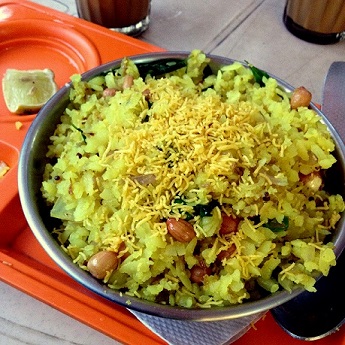
Image credit: Advaitj11
Oil-free Breakfast Vegan Poha Recipe with Step By Step Instructions
How to Make Poha - Whole Food Plant Based Poha Recipe
Course: Breakfast
Course 3: Grain Dishes for Lunch & Dinner Meals
Cuisine: Maharashtra Recipe from North India
Prep Time: 5 minutes
Cook Time: 15 minutes
Servings: 2 servings
BASIC INGREDIENTS
1/2 cup Flattened Red Rice / Red Rice Poha / Red Rice Aval (Poha variety - use thick)
1/2 cup Fresh Green Peas or Cubed Potatoes
1 Onion
1/2 Green Chili
1 tsp Turmeric Powder
1/2 tsp Black Pepper Powder
3 tsp Miso Paste made with 1/2 teaspoon salt (Healthy Salt Alternative, see Nutrition Science Highlights)
Juice of 1/2 Lemon for Garnishing with Fresh Lemon Juice
1/2 tsp Garam Masala
¾ teaspoon Mustard Seeds, Roasted
¾ teaspoon Cumin Seeds, Roasted
2 Tablespoons Peanuts, Mildly Roasted
2 tbsp Coriander Leaves & Stems Chopped
8-10 Curry Leaves
STEP BY STEP INSTRUCTIONS - POHA RECIPE CARD
- Sprinkle drinking water on poha, just enough soak poha in water. Leave it aside for a 5-6 minutes to absorb the water and soften. You can also wash the poha and keep washed poha aside. Whatever you do, ensure not to use excess water. Using excess water makes poha mushy. Between cold water and hot water, I personally prefer hot water as it is a little faster. Plain water is good, no need to add salt at this point.
- Peel and chop onion into long, thin slices to make onion poha. Chop green chili, Saute onion and chili on medium heat with a few spoons of water for a minute or two until cooked. Add fresh green peas and some more water. Cover and cook. It is important to cover so the water does not evaporate. If you don't cover, peas may get burnt as we don't even use one tablespoon oil. Just use raw chili, onions and tomatoes for a quicker version that takes less than a minute.
- Once cooked, remove from stove and mix in turmeric powder, black pepper powder, miso paste, and garam masala. Squeeze 1-2 teaspoon lemon juice. Mix poha in. If too wet, continue keeping on medium-low heat for 12-minutes. Be careful not to cook for more than a couple of minutes or stir too hard to make fluffy poha.
- For the roasting step, simply skip the oil - that's zero teaspoon of oil - and dry roast mustard seeds, cumin seeds and raw peanuts separately for 1-2 minutes. Remember not to brown roasted peanuts. This is a crucial step to prevent cancer causing AGEs from forming. Always heat to medium or low, never take the kadai heat to high. You can also heat to medium, switch off the stove and let the spices get roasted in retained heat. The kadai heat itself would be enough to roast a few teaspoon mustard seeds. You can make this in advance and use the retained heat to dry roast poha lightly before soaking. Remember to use zero teaspoon of oil!
- Garnish with a flavorful tempering of roasted mustard seeds, roasted cumin seeds, roasted peanuts, chopped coriander leaves and chopped curry leaves. Adjust for perfect taste. Serve fresh!
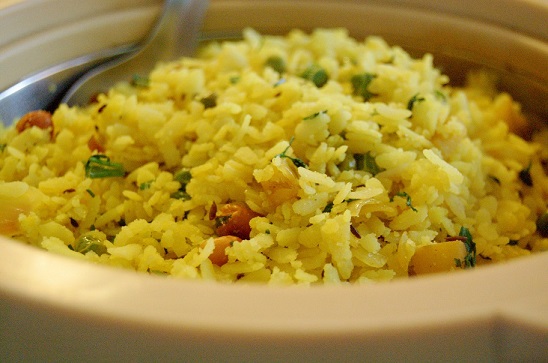
Image Credit: ampersandyslexia
Plant-based Chef Pro Tips for Plant Based Poha Recipes - Even Instant Pot Poha Recipe!
- To avoid burning, always use medium-low heat with a splash of water in case it gets dry every 1-2 minutes. While making this onion poha recipe, this is especially important. Avoid disappointment by ensuring to roast onion in water - they make for a great onion poha.
- Poha is a popular breakfast, but if it is for an evening snack, try serving with some baked delicacies like capsicum pakora, stuffed capsicum bonda. These snacks are typically fried and served with the popular street food poha, but remember to bake your capsicum pakora and stuffed capsicum bonda rather than frying, so that you don't use even ½ tablespoon oil to make these common starters.
- You can garnish with ground coconut or coconut slices as an additional ingredient too. Adding 1-2 tbsp coconut will get you the perfect taste of Maharashtra or coastal South India, but fresh coconut is high in saturated fat. Due to this, it has only a neutral effect on health. We don't recommend consuming ground coconut or coconut slices regularly, reserve it for special occasions. Coconut slices are healthier than grated coconut. 1 tbsp coconut would be enough for 4 servings, and 2 tbsp coconut for 8 servings. Healthiest is to just use a small quantity of peanuts. In fact, even a good quantity of peanuts would be healthier than using fresh coconut, like 1-2 tbsp peanuts.
- To get an even nicer 'roasted in oil' fragrance, dry roast 2-3 whole red chillies and mix into your recipewhile garnishing. It takes just a minute, but boosts the authenticity of your recipe by a lot.
- To make your poha taste even fresher, add an extra teaspoon lemon juice after the roasting step, when you add ¾ teaspoon Mustard Seeds.
- Many recipes call for 1 tsp sugar. For a similar restaurant-style taste but without the table sugar, use the same amount of homemade date syrup. One teaspoon sugar can be replaced with one teaspoon date syrup.
- If you have added too much water and made mushy poha, mix a few teaspoons of roasted besan or chickpea flour to absorb the water and make it dry again. This can help you avoid making poha mushy
- Most recipes online call for 2-3 green chillies for the same recipe. However, since we are tempering in water and not in oil, the spice levels will hit the roof with this amount of spicy taste! That's why this recipe uses just 1/2 green chilli.
- This poha recipe is made garam masala using basic spices and black pepper powder. If you don't have these basic spices, simply garnish with turmeric powder and cumin powder, whatever is available in your kitchen.
- Instant pot poha can also be made with this recipe. Just cook the onions and spices in an instant pot for 5 minutes with a splash of water and then mix in soaked poha.
- You could even make your own chilli sauce for a chinese cuisine recipe. Make it using green chili, onion, garlic, water and miso paste. Adding this sauce with cooking instead of green chili gives a chinese flavour.
- Enjoy your beaten rice with these healthy yet popular alternatives on regular days and in the festive season too! That's how the versatile behavior of poha flakes can help you when you run out of ideas - it is one of the most common recipes that anyone would recognise as popular Indian veg recipes. Serve with a piping hot curry recipe or just by itself! Check out our featured recipes on the Plant Based Recipes free course to learn more.
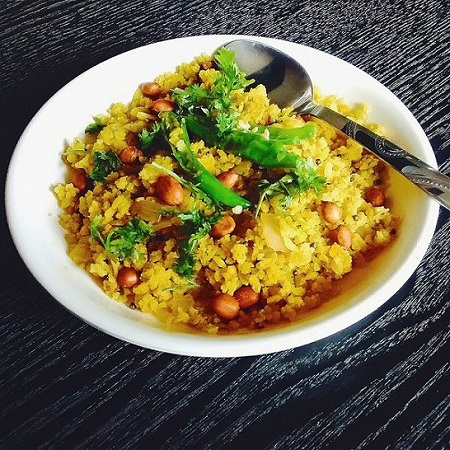
Image Credit: Monali.mishra
Which Curry Recipe to Serve with Instant Pot Poha?
- Poha is a dry snack. You can either serve it as one of your breakfast recipes, a savory snack, street food snack or a simple dish with a restaurant style curry like paneer butter masala, paneer cashew curry, paneer chilli dry, or kadai paneer.
- Wait a minute - isn't paneer a dairy product? Simple replace paneer with tofu in any paneer sabzi recipe and you can convert a fancy paneer curry to a delicious and nutritious tofu curry - even a restaurant-style paneer delicacy!
How to Make Poha Rava Idli with Instant Poha Rava?
- Make instant poha rava by simply grinding it to a rough powder to make instant poha idli. Poha rava idli gets cooked within minutes. The crucial step is to grind it rough, not smooth.
- Just mix instant poha rava with soya curds, 1/2 teaspoon salt in the form of miso paste, minced green chili, and cumin seeds and steam for 10 minutes in an idli cooker to make poha rava idli. Top with 1-2 tbsp peanuts before steaming for a fancy recipe.
- This could be an innovative way of introducing poha in thali meals. This way, you can avoid the risk of mushy poha. You can make this an Instant pot poha recipe too.
- Poha variety - use thick type of poha to make onion poha, and thin type of poha to make chivda
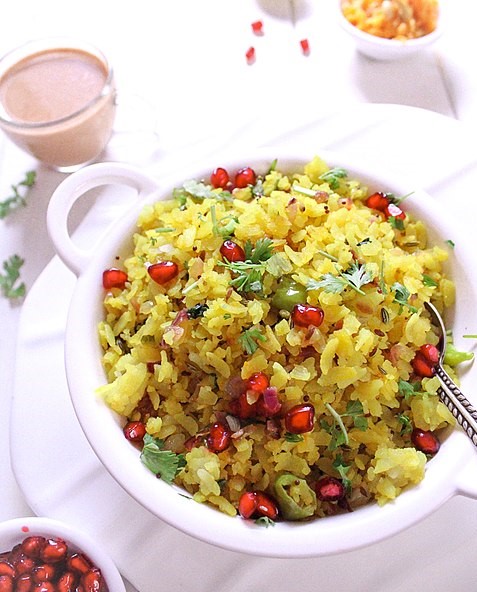
Image Credit: Mahi Gajwani
How to Make Different Indian Breakfasts of Different Cuisine with Poha?
- This is a Maharashtrian Breakfast Recipe. For a South Indian flavour, avoid garam masala, use 10-12 curry leaves extra, and 1/2 tsp roasted fennel seeds. An extra tbsp peanuts can help too!
Are Potatoes Healthy? How to make Batata Poha with Capsicum?
- To add more vegetables, try cooking cubed potatoes, cubed carrots, chopped capsicum and chopped cauliflower in 2 cups of water.
- Use plain water, not salted water. Your vegetables taste just as good with plain water, without the extra sodium intake.
- Yes, potatoes are not unhealthy - potatoes are neutral for health, similar to coconut.
Nutrition Science Highlights of Whole Food Plant Based Easy Poha Recipe:
- Why Miso Paste? Miso paste is fermented & salted soya bean paste. American Heart Association Maximum recommended maximum daily salt intake of 3.75 grams per person to minimise risk of high blood pressure, stomach cancer and chronic kidney disease. In addition to helping us restrict salt intake, replacing salt with miso paste also helps by neutralising the negative effects of salt by soya phytonutrients. You can easily make fresh miso paste at home by mixing 100 grams of cooked soya paste with 10 grams or 2 teaspoon salt, or 10 tablespoons of cooked soya paste with 1 tablespoon salt. If making at home, ensure to use immediately, or freeze in batches to use later. Or, simply use 3.75 grams of salt or less per day per person and add 18 to 20 grams (dry weight) of soya beans in any dishes, spread through the day!
How to Make Oil-free Tempering for this Popular Breakfast?
- Why not tadka? Tadka, thaaLippu, oggaraNe. Flavorful tempering of spices in oil is quintessential to Indian cuisine. Tempering of mustard may have started as a compromise when whole nuts were unavailable, and indeed, is more common in inland, drier areas where nuts do not grow easily, all year round. You can enjoy the taste and fragrance of Indian cuisine by just dry roasting the spices you require, without the oil, or even better, mixing spice powders directly into your dish!
